Circuit-Zone.com - Electronic Projects
Posted on Sunday, January 30, 2011 • Category: Amplifiers
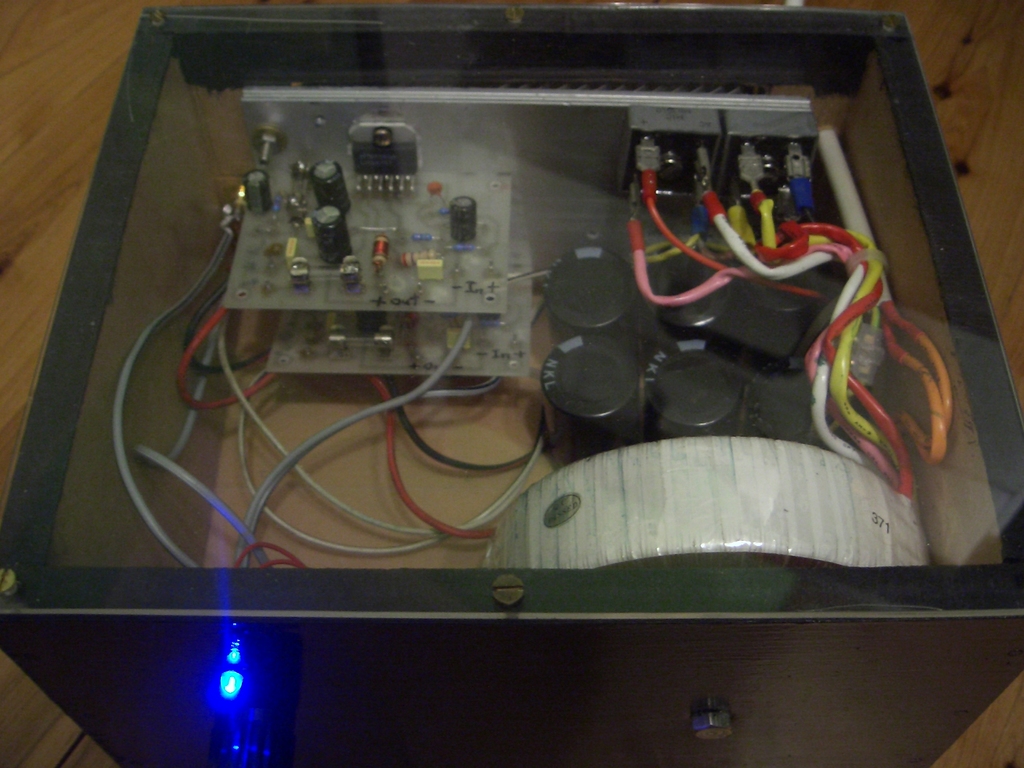
It is a 2x56W stereo amp based on National Semiconductor's LM3876T chip (they come in 2 versions T and TF the latter having an insulated case), this type of amp is also known as a gainclone because it is an improved copy of Gaincard amplifier. seriously this amp can outperform most commercial amplifiers/receivers (minus the video upscaling/switching) when built properly ie it has very low THD you will not be disappointed by how good it sounds . When connected to AV equipment such as dvd players this thing gets insanely loud (despite having only 56W per channel), i've have never required more than 25% volume because it hurts my ears NOTE: a even
more powerful version using the same circuit with a LM3886 chip can be made giving 68W per channel.
Posted on Sunday, January 30, 2011 • Category: Amplifiers
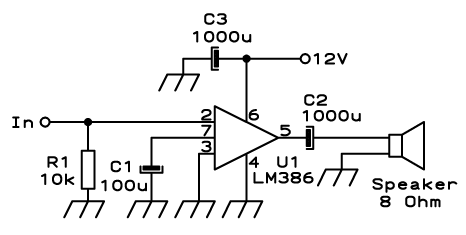 Many electronic projects require the use of a small audio amplifier. Be it a radio transceiver, a digital voice recorder, or an intercom, they all call for an audio amp that is small, cheap, and has enough power to provide adequate loudness to fill a room, without pretending to serve a disco! About one Watt RMS seems to be a convenient size, and this is also about the highest power that a simple amplifier fed from 12V can put into an 8 Ohm speaker. A very low saturation amplifier may go as high up as 2 Watt, but any higher power requires the use of a higher voltage power supply, lower speaker impedance, a bridge circuit, or a combination of those.
During my many years building electronic things I have needed small audio amps many times, and have pretty much standardized on a few IC solutions, first and and foremost the LM386, which is small, cheap, and very easy to use. But it does not produce high quality audio... For many applications, the advantages weigh more than the distortion and noise of this chip, so that I used it anyway. In other cases I used different chips, which perform better but need more complex circuits. Often these chips were no longer available the next time I needed a small amplifier.
Posted on Saturday, January 29, 2011 • Category: FM Transmitters
 This unit is an updated version of the Wide Dynamic Range Field Strength Meter. While the basic function is the same, it has several critical differences:
It uses a specialized integrated circuit, the Analog Devices AD8307. This chip is designed specifically as a logarithmic amplifier for use through 500 MHz.
Using the AD8307, it has a wider dynamic range (85 dB versus 55 dB) and it has built-in temperature compensation.
Because of the different nature of this type of detector - and the fact that it has temperature compensation - means that there is no need for a "zeroing" control.
One disadvantage of this approach as compared to the diode approach is that the AD8307 has a lower frequency response than the diode. The frequency limit of the meter is dictated pretty much by the diodes themselves along with their physical layout and related components: There is no reason why the earlier version could not be constructed to work through 10 GHz or so - but the AD8307 is falling flat by the time you get to 1 GHz, making it unsuitable for detecting wireless LANs or PCS-type cell phones.
Posted on Thursday, January 27, 2011 • Category: Oscilloscopes
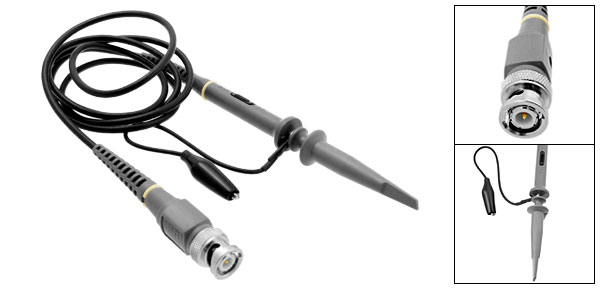 Passive Probe are the most general used scope probe. As the name "passive" suggest, it is made from passive components resistor, capacitor & wires. The leading scope probe maker are LeCroy, Tektronix & Agilent.
Passive probe usually comes with attenuation factor of 1:1, 10:1 and 100:1. Attenuation factor of 1:1 means whatever signal being probe at the probe tip will be shown exactly as it is at the oscilloscope input. So a signal of 1V at the probe tip will be detected as 1V at the scope input.
Attenuation factor of 10:1 means that a signal of 1V at probe tip will be detected as 0.1V at the scope input.
Posted on Thursday, January 27, 2011 • Category: FM Transmitters
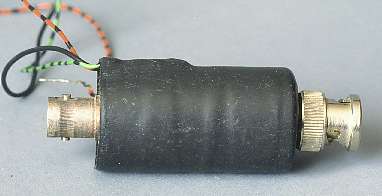 Everyone involved with radio transmitters needs some instruments to assess basic antenna functionality. Among these instruments, the best-known and most-used one is the Standing Wave Ratio meter. Some radio amateurs develop a cult for these little gadgets, having them in line all the time and watching the needles bounce while they chat. I have seen some guys owning 5 or 6 SWR meters, and no other instrument relating to antenna testing! While it's unfortunate that some people - specially amateurs - assign so much importance to SWR and so little to other parameters, it's also a fact that SWR needs to be known, so if you use transmitters, you need an SWR meter.
Posted on Thursday, January 27, 2011 • Category: Amplifiers
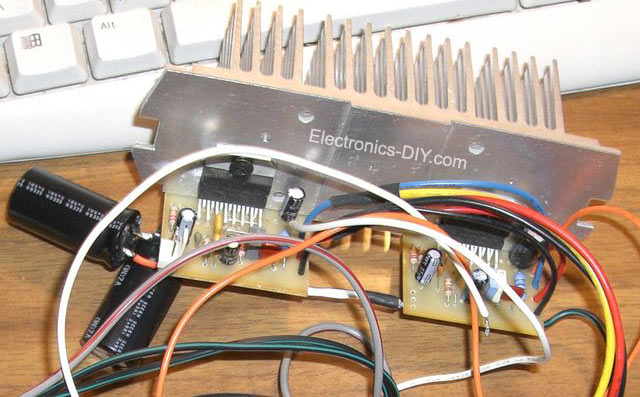 The following is a 70W amplifier based on a popular TDA7294 chip. Main technical characteristics of the amplifier are as follows: input resistance - 22 kOhm input voltage - 750 mV nominal output power at 4 ohms and THD 0.5% - 70 Watts Frequency Range - 20 ... 20000 Hz supply voltage - ± 27 V, quiescent current - 60 mA. The amplifier has a built-in thermal protection, and protection against overload and short circuit in the load. For "soft" switching amplifier is SA1. Switch can be powered from a bipolar unregulated power supply. Power AC Transformer - 250-A, the secondary winding should be designed to current than 5A.
Posted on Thursday, January 27, 2011 • Category: Power Supplies
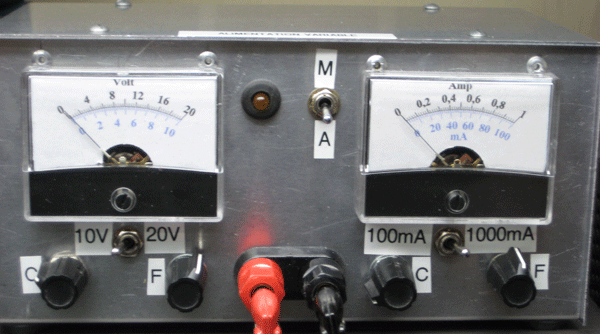 With a maximum capacity of 20 volts and 1 amp, it will supply most of your projects, it's greatest quality is the protection all your projects, it is capable of limiting the maximum current to as low as 1mA, saving your ICs and transistors in case of an accidental short circuit during the experimenting period of your projects. It is also an excellent battery charger.
Posted on Wednesday, January 26, 2011 • Category: FM Transmitters
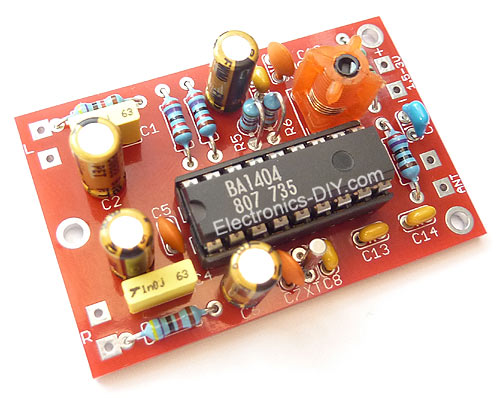 Be "On Air" with your own radio station! BA1404 HI-FI Stereo FM Transmitter - Special Edition Kit is an exciting transmitter that will broadcast high quality stereo signal in 88MHz - 108MHz FM band. It can be connected to any type of stereo audio source such as iPod, Computer, Laptop, CD Player, Walkman, Television, Satellite Receiver, Tape Deck or other stereo system to transmit stereo sound with excellent clarity throughout your home, office, yard or camp ground. Add 500mW FM / VHF Transmitter Amplifier / Booster for even longer range.
Special Edition BA1404 HI-FI Stereo FM Transmitter Kit includes premium components with audio grade gold capacitors, 1% Metal Film Resistors and quality PCB with Red Solder Mask and Plated-Through Holes. The kit is based on the popular BA1404 stereo broadcaster IC which contains all the complex circuitry for generating the stereo FM signal. 38 KHz crystal provides a rock solid stability of sub-carrier for stereo signal.
Posted on Wednesday, January 26, 2011 • Category: Power Supplies
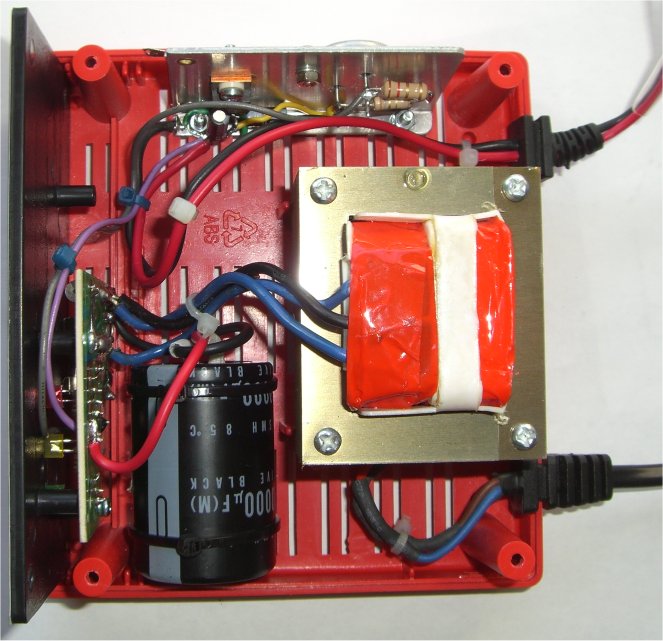 As you might expect, I have several power supplies that have more than enough capacity to power my new KN-Q7 transceiver. However, my largest power supply is normally connected to my main 100W PEP SSB transceiver. It is capable of 20A and more, but it’s not easy to connect other equipment to it. I also have a smaller 8A power supply, but I use this to power some other VHF and UHF transceivers.
In short, I wanted a simple power supply which I could dedicate to this new transceiver.
Posted on Friday, January 21, 2011 • Category: Test and Measurement
This is 60 MHz frequency meter / counter for measuring frequency from 10 Hz to 60 MHz with 10 Hz resolution. It is a very useful bench test equipment for testing and finding out the frequency of various devices with unknown frequency such as oscillators, radio receivers, transmitters, function generators, crystals, etc. The meter provides very stable readings and has excellent input sensitivity thanks to onboard amplifier and TTL converter, so it can even measure weak signals from crystal oscillators. With the addition of prescaller it is possible to measure the frequency of 1GHz and above. The meter measuring range has been recently upgraded and it can now measure from 10Hz to 60MHz instead of 10Hz to 50MHz.
Circuit-Zone.com © 2007-2026. All Rights Reserved.
|